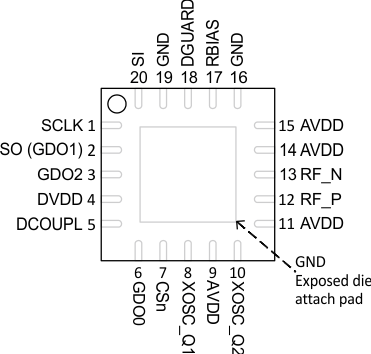ZHCS269C May 2011 – December 2016 CC110L
PRODUCTION DATA.
- 1器件概述
- 2修订历史记录
- 3Terminal Configuration and Functions
-
4Specifications
- 4.1 Absolute Maximum Ratings
- 4.2 Handling Ratings
- 4.3 Recommended Operating Conditions
- 4.4 General Characteristics
- 4.5 Current Consumption
- 4.6 Typical RX Current Consumption Over Temperature and Input Power Level, 868 or 915 MHz
- 4.7 RF Receive Section
- 4.8 RF Transmit Section
- 4.9 Crystal Oscillator
- 4.10 Frequency Synthesizer Characteristics
- 4.11 DC Characteristics
- 4.12 Power-On Reset
- 4.13 Thermal Characteristics
- 4.14 Typical Characteristics
-
5Detailed Description
- 5.1 Overview
- 5.2 Functional Block Diagram
- 5.3 Configuration Overview
- 5.4 Configuration Software
- 5.5 4-wire Serial Configuration and Data Interface
- 5.6 Chip Status Byte
- 5.7 Register Access
- 5.8 SPI Read
- 5.9 Command Strobes
- 5.10 FIFO Access
- 5.11 PATABLE Access
- 5.12 Microcontroller Interface and Pin Configuration
- 5.13 Data Rate Programming
- 5.14 Receiver Channel Filter Bandwidth
- 5.15 Demodulator, Symbol Synchronizer, and Data Decision
- 5.16 Packet Handling Hardware Support
- 5.17 Modulation Formats
- 5.18 Received Signal Qualifiers and RSSI
- 5.19 Radio Control
- 5.20 Data FIFO
- 5.21 Frequency Programming
- 5.22 VCO
- 5.23 Voltage Regulators
- 5.24 Output Power Programming
- 5.25 General Purpose and Test Output Control Pins
- 5.26 Asynchronous and Synchronous Serial Operation
- 5.27 System Considerations and Guidelines
- 5.28 Configuration Registers
- 5.29 Development Kit Ordering Information
- 6Applications, Implementation, and Layout
- 7Device and Documentation Support
- 8Mechanical Packaging and Orderable Information
3 Terminal Configuration and Functions
3.1 Pin Diagram
The CC110L pinout is shown in Figure 3-1 and Table 3-1. See Section 5.25 for details on the I/O configuration.
 Figure 3-1 Pinout Top View
Figure 3-1 Pinout Top View
3.2 Signal Descriptions
Table 3-1 Signal Descriptions
| Pin No. | Pin Name | Pin Type | Description |
|---|---|---|---|
| 1 | SCLK | Digital Input | Serial configuration interface, clock input |
| 2 | SO (GDO1) | Digital Output | Serial configuration interface, data output |
| Optional general output pin when CSn is high | |||
| 3 | GDO2 | Digital Output | Digital output pin for general use:
|
| 4 | DVDD | Power (Digital) | 1.8 - 3.6 V digital power supply for digital I/O's and for the digital core voltage regulator |
| 5 | DCOUPL | Power (Digital) | 1.6 - 2.0 V digital power supply output for decoupling |
|
NOTE: This pin is intended for use with the CC110L only. It can not be used to provide supply voltage to other devices |
|||
| 6 | GDO0 | Digital I/O | Digital output pin for general use:
|
| 7 | CSn | Digital Input | Serial configuration interface, chip select |
| 8 | XOSC_Q1 | Analog I/O | Crystal oscillator pin 1, or external clock input |
| 9 | AVDD | Power (Analog) | 1.8 - 3.6 V analog power supply connection |
| 10 | XOSC_Q2 | Analog I/O | Crystal oscillator pin 2 |
| 11 | AVDD | Power (Analog) | 1.8 - 3.6 V analog power supply connection |
| 12 | RF_P | RF I/O | Positive RF input signal to LNA in receive mode |
| Positive RF output signal from PA in transmit mode | |||
| 13 | RF_N | RF I/O | Negative RF input signal to LNA in receive mode |
| Negative RF output signal from PA in transmit mode | |||
| 14 | AVDD | Power (Analog) | 1.8 - 3.6 V analog power supply connection |
| 15 | AVDD | Power (Analog) | 1.8 - 3.6 V analog power supply connection |
| 16 | GND | Ground (Analog) | Analog ground connection |
| 17 | RBIAS | Analog I/O | External bias resistor for reference current |
| 18 | DGUARD | Power (Digital) | Power supply connection for digital noise isolation |
| 19 | GND | Ground (Digital) | Ground connection for digital noise isolation |
| 20 | SI | Digital Input | Serial configuration interface, data input |